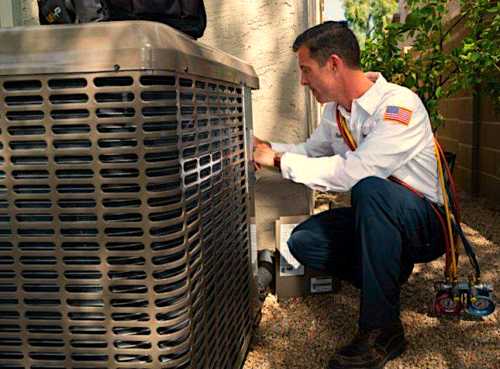What Size Central Air Conditioner Do I Need for My Phoenix Home?
March 06, 2023
Many Phoenix homeowners who are looking for a new AC ask us, “What size AC should I get?”
It’s a good question with a not-so-simple answer. But don’t worry, we’re here to help!
It’s impossible for us to tell you what size AC you need in a blog article, as AC size depends on many factors, but we’ll help unravel the size mystery of BTU to square feet. Our goal is to keep you well informed and give you the questions you should ask your Patrick Riley | Isley's technician when they visit your home.
What Size AC Do I Need?
All homes are different, and the only accurate way to know what size AC you need is to have a professional visit your home and perform a cooling load calculation. A cooling calculation is an assessment that takes into account several factors to determine what size AC you need.
If you search on the web for this answer, some sources will tell you to simply match your AC size to the square footage of your home, and they’ll share generic AC sizing charts like the BTU to square feet chart below:
- 1,000–1,200 sq/ft = 21,000 BTUs
- 1,200–1,400 sq/ft = 23,000 BTUs
- 1,400–1,500 sq/ft = 24,000 BTUs
- 1,500–2,000 sq/ft = 30,000 BTUs
- 2,000–2,500 sq/ft = 34,000 BTUs
- 2,500–3,000+ sq/ft = 42,000–60,000 BTUs
Knowing how many square feet a capable AC can cover is a great start. However, square footage is only ONE factor that determines AC size—not the only factor—and getting it wrong can cost you money or your cool when you need it most!
In this article, we’ll highlight how you can anticipate the size of AC you need and cover these topics:
- How AC size is measured
- Why you need the right size AC
- Why you need a professional to help you with your decision
How AC Size Is Measured

Earlier, we shared a chart that compared square footage with British Thermal Units (BTUs). Air conditioners get their size from this measurement, which determines how much heat the system can remove from your home in one hour.
Most homes need ACs that range from 18,000 to 60,000 BTUs.
Sometimes you’ll see air conditioner size measured in tons instead of BTUs. Tonnage is just another way of expressing an air conditioner’s cooling performance.
Below is an AC sizing chart to help you compare tonnage with BTU output:
- 1 ton = 12,000 BTUs
- 1.5 tons = 18,000 BTUs
- 2 tons = 24,000 BTUs
- 2.5 tons = 30,000 BTUs
- 3 tons = 36,000 BTUs
- 3.5 tons = 42,000 BTUs
- 4 tons = 48,000 BTUs
- 4.5 tons = 54,000 BTUs
- 5 tons = 60,000 BTUs
By converting tonnage to BTUs, you should have a clear understanding of what size AC you might need for a 1,000, 2,000, or 3,000 square-foot house. Now that you know how AC size is measured, let’s look at why you need the right size AC.
Why You Need the Correct AC Size
“Does AC size really matter?”
We often get that question from Phoenix homeowners. The size of your AC is critically important, and here’s why:
- If your AC is undersized, it will run nonstop trying to cool your home. As a result, you’ll spend more than you should on energy bills, and your home will never reach your desired temperature.
- If your AC is oversized, you’ll run into an issue known as “short cycling.” Short cycling is when your AC turns on, cools your home really fast (since it’s so big), then shuts off quickly.
You might think that a large, high-powered unit is a good thing, but it actually leads to problems like these:
- High energy bills— The more your AC starts and stops, the more energy it consumes. Similar to a car getting better gas mileage when it runs longer, your AC is more efficient and uses less energy if it’s allowed to run for a longer period of time.
- Uneven cooling in your home — Since the AC shuts off so abruptly, the fan doesn’t have enough time to properly circulate cold air throughout your home, leaving you with uneven cooling. Some spots will be warmer than they should be, and some spots will be cooler than you want them to be.
- More frequent repairs — The constant on and off caused by short cycling wears down motors and other components in your AC system, which will ultimately reduce its lifespan.
Now that you know AC size does matter, let’s look at why you need a professional to help you find the right size air conditioner for your home.
Why You Need a Professional to Help You Choose the Right Size AC

The only accurate way to determine what size AC your home needs is to have a professional perform a cooling load calculation.
A cooling load calculation will tell you the BTU output you need for your new air conditioner. It considers factors like these:
- The square footage of your home
- Your home’s geographical location
- Your home’s insulation
- The height of your ceilings
- The number of doors and windows in your home
- The type/angle of your roof
- The current condition and layout of your ducts
- The orientation of your home (i.e., north facing, east facing, etc.)
- And much more
Don’t take chances or make guesses when it comes to sizing your AC to fit your home! Call a Patrick Riley | Isley's expert to visit with you about your particular needs.
Watch Out for Contractors Who Use a Square Footage “Rule-of-Thumb” Approach
As you can see, determining what size air conditioner you need depends on much more than square footage alone. If a contractor tells you something like “You just need 12,000 BTUs for every square foot of your home,” they’re not giving you the full picture or taking your needs into account. Incorrect AC sizing forces homeowners to purchase an AC system that will be the wrong size.
Call the experts at Patrick Riley | Isley's. We’ll guide you through every step of the process and take the time to answer all of your questions.
Ready to Talk with an AC Pro in Phoenix?
We’ll send over one of our friendly techs to perform a cooling load calculation to help you find the right size AC for your home. Here’s what you can expect:
- Polite, professional customer service
- Upfront pricing
- 100% satisfaction guaranteed on all of our AC services
Originally published: July 12, 2019
Written by: Patrick Riley | Isley's
Related articles:
Get 10% off (Up to $150)

Ty Lindsay is the Director of Field Operations at Patrick Riley | Isley’s and a 15-year veteran of the plumbing and HVAC trades. In 2010, Ty earned his Journeyman’s plumbing license. He became a Master Plumber five years later and earned his Journeyman HVAC technician’s license that same year. Ty’s breadth of knowledge in plumbing and HVAC includes both residential and commercial work. He’s been a loyal member of the Patrick Riley | Isley’s team since 2016.
- Posted in:
- Buyer's Guide
